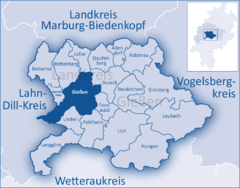Gießen
| Gießen | |
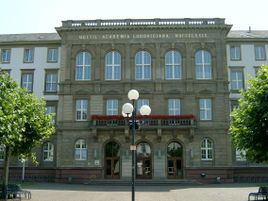 |
|
 |
|
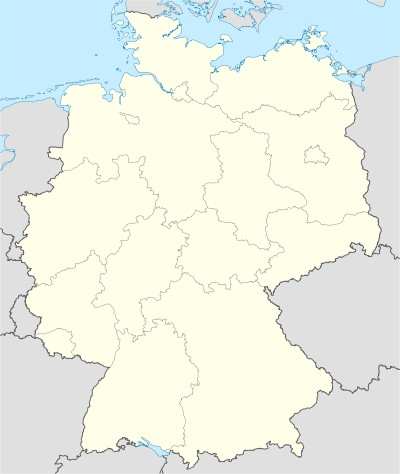 Gießen
|
|
|
Location of the town of Gießen within Gießen district
|
|
|---|---|
| Coordinates | |
| Administration | |
| Country | Germany |
| State | Hesse |
| Admin. region | Gießen |
| District | Gießen |
| Town subdivisions | 6 Stadtteile |
| Lord Mayor | Dietlind Grabe-Bolz (SPD) |
| Basic statistics | |
| Area | 72.562 km2 (28.016 sq mi) |
| Elevation | 155-304 m |
| Population | 76,090 (31 December 2009)[1] |
| - Density | 1,049 /km2 (2,716 /sq mi) |
| Other information | |
| Time zone | CET/CEST (UTC+1/+2) |
| Licence plate | GI |
| Postal codes | 35331–35398 |
| Area codes | 0641, 06403 |
| Website | www.giessen.de |
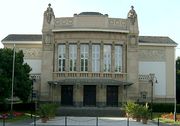
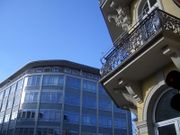
Gießen (German pronunciation: [ˈɡiːsən], locally [ˈɡiːzən]) is a town in the German federal state (Bundesland) of Hesse, capital of both the district of Gießen and the administrative region of Gießen. The population is approximately 71,000, with roughly 22,000 university students.
The name comes from Giezzen, as it was first referred to in 1197, which refers to the position of the town between several rivers, lakes and streams. The largest river in Gießen is the Lahn, which divides the town in two parts (west and east), roughly 50 kilometres north of Frankfurt am Main.
Contents |
History
Gießen came into being as a moated castle in 1152, built by Count Wilhelm von Gleiberg, although the history of the community in the northeast and in today's suburb called "Wieseck" dates back to 775. The town became part of Hesse-Marburg in 1567, passing to Hesse-Darmstadt in 1604. The University of Gießen was founded in 1607. Gießen was included within the Grand Duchy of Hesse, created in 1806 during the Napoleonic Wars. After World War I, it was part of the People's State of Hesse.
During World War II, a subcamp of the Buchenwald concentration camp was located in the town.[2]. Heavy bombing destroyed about 75% of Gießen in 1944, including most of the town's historic buildings. It became part of the modern state of Hesse after the war.
In 1977 Gießen was merged with the neighboring city Wetzlar to form the new city of Lahn; however, this attempt to reorganize the administration was reversed in 1979.
An American military base was located in Gießen after World War II. The U.S. Army Garrison Gießen, has a population of 500 Americans. The base is a converted German Army Air Field, which is reflected in some of the buildings, including the housing area. A theater, known as the Keller Theater, is a converted German army Officer's Club. As of September 28, 2007, the Gießen Depot, and all other communities in the greater Gießen area were turned back over to the local German authorities.
After the war, the city was twinned with Winchester, UK.[3]
International relations
Gießen is twinned with:
Points of interest
- Akademischer Forstgarten Gießen
- Botanischer Garten Gießen, established in 1609, the oldest botanical garden in Germany still at its original location.
- Old Cemetery, German: Alter Friedhof, resting place of Wilhelm Conrad Röntgen and Hugo von Ritgen.
- Liebig Museum, established in 1920, to honor the chemist Justus von Liebig.
People
- Landgravine Elisabeth Amalie of Hesse-Darmstadt (1635–1709), Electress Palatine, ancestress of most of today's royals
- Johann Georg Rosenmüller (1736–1815), professor of theology at the university
- Justus von Liebig (1803–1873), chemist, professor. The official name of the University of Gießen is now Justus Liebig University
- Samuel Adler (1809–1891), a noted rabbi in the United States, attended the University of Gießen[4]
- Georg Büchner (1813–1837) studied two years at the University of Gießen
- Wilhelm Liebknecht (1826–1900), founder of the Social Democratic Party of Germany, was born on March 29, 1826 in Gießen
- Adolph Hansen (1851–1920), botanist and professor at University of Giessen
- Wilhelm Conrad Röntgen (1845–1923), physicist, professor of physics from 1879 until 1888 at the university of Gießen. He was buried at the "Alte Friedhof", where his tomb can still be found
- Alfred Milner (1854–1925), British statesman
- Wilhelm Sievers (1860–1921), geographer, explorer, professor at the university
- Marie Wittich (1868–1931), opera singer
- Friedrich Kellner (1885–1970), Chief Regional Auditor in Gießen 1948-1950, and Chief Justice Inspector of Laubach, where he wrote his secret WWII diary. The Holocaust Research Unit of Justus Liebig University of Gießen has established the Kellner Project
- Fritz Heichelheim (1901–1968), economist
- James J. O'Donnell (b. 1950), American scholar and University administrator, born in Giessen
- Stefan Bellof (1957–1985), Formula One and Sportscar driver, who died during a race held in Spa-Francorchamps
- Demis Nikolaidis (1973– ), Greek footballer
Education
- University of Gießen
- University of Applied Sciences Gießen-Friedberg
- MBML: The International Graduate Programme "Molecular Biology and Medicine of the Lung" of the University of Giessen Lung Center
- University Clinic, Giessen-Marburg.
Manisch
Manisch is a dialect of rotwelsch spoken in and around Gießen by people in lower income neighborhoods, some of which are known as "Eulenkopf", "Gummiinsel", "Heyerweg" and "Margaretenhütte". Approximately 700–750 residents spoke the dialect fluently as of 1976.[5] Although the dialect still influences the Gießen vernacular, it is nearly extinct in terms of fluent speakers.
References
- Notes
- ↑ "Die Bevölkerung der hessischen Gemeinden" (in German). Hessisches Statistisches Landesamt. 31 December 2009. http://www.statistik-hessen.de/themenauswahl/bevoelkerung-gebiet/regionaldaten/bevoelkerung-der-hessischen-gemeinden/index.html.
- ↑ Edward Victor. Alphabetical List of Camps, Subcamps and Other Camps.
- ↑ ""USAG Giessen Folds Up Tent"". http://www.military.com/features/0,15240,153028,00.html. Retrieved 2008-05-08.
- ↑ Who Was Who in America, Historical Volume, 1607-1896. Marquis Who's Who. 1967.
- ↑ Hans-Günter Lerch, "Tschü lowi...Das Manische in Gießen", 1976/2005, pages 16-22.
External links
- Express Magazine - Current events and news from Gießen
- LTi Giessen 46ers Basketball
- City Services Giessen (SWG)
- [1]
- [2]
|
|||||||
